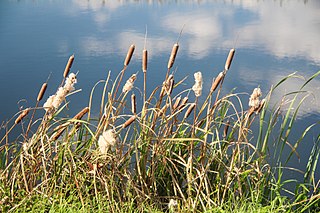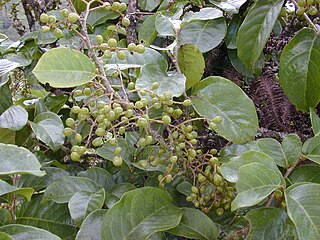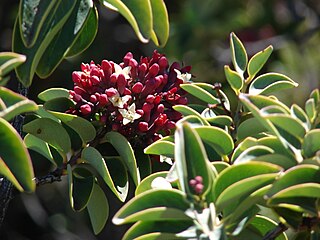
Thespesia populnea, commonly known as the portia tree, Pacific rosewood, Indian tulip tree, or milo, among other names, is a species of flowering plant belonging to the mallow family, Malvaceae. It is a tree found commonly on coasts around the world. Although it is confirmed to be native only to the Old World tropics, other authorities consider it to have a wider, possibly pantropical native distribution. It is thought to be an invasive species in Florida and Brazil.

Hibiscus tiliaceus, commonly known as the sea hibiscus or coast cottonwood, is a species of flowering tree in the mallow family, Malvaceae, with a pantropical distribution along coastlines. It has also been introduced to Florida and New Zealand. It has been debated whether this species is native or introduced to Hawaii.

Typha latifolia is a perennial herbaceous plant in the genus Typha. It is found as a native plant species in North and South America, Eurasia, and Africa.

Antidesma platyphyllum is a species of flowering tree in the leafflower family, Phyllanthaceae, that is endemic to Hawaii. Common names include hame, haʻā, mehame, hamehame, mēhamehame, and haʻāmaile. It inhabits coastal mesic forests, mixed mesic forests, wet forests, and bogs at elevations of 150–1,525 m (492–5,003 ft) on all main islands.

Mezoneuron kavaiense is a rare shrub or small tree in the genus Mezoneuron, that is endemic to Hawaii. Common names include Uhiuhi, Kāwaʻu (Maui), and Kea (Maui). It is threatened by invasive species, particularly feral ungulates.

Cibotium menziesii, the hāpuʻu ʻiʻi or Hawaiian tree fern, is a species of tree fern that is endemic to the islands of Hawaiʻi. It is named after the Scottish naturalist Archibald Menzies. It is also known as the male tree fern, and Cibotium glaucum is deemed the female tree fern due to differences in color.

Flueggea neowawraea, the mēhamehame, is a species of flowering tree in the family Phyllanthaceae, that is endemic to Hawaii. It can be found in dry, coastal mesic, and mixed mesic forests at elevations of 250 to 1,000 m. Associated plants include kukui, hame, ʻahakea, alaheʻe, olopua, hao, and aʻiaʻi. Mēhamehame was one of the largest trees in Hawaiʻi, reaching a height of 30 m (98 ft) and trunk diameter of 2 m (6.6 ft). Native Hawaiians used the extremely hard wood of this tree to make weaponry.

Gardenia brighamii, commonly known as nānū, naʻu, or forest gardenia, is a species of flowering plant in the coffee family, Rubiaceae, that is endemic to Hawaii.

Dracaena fernaldii, synonym Pleomele fernaldii, is a species of flowering plant that is endemic to the island of Lānaʻi in Hawaiʻi. It is known by the common name Lanai hala pepe. It can be found in dry forests at elevations of 490–670 metres (1,610–2,200 ft). It is threatened by habitat loss. 400-1000 of these plants remain in the wild, but little recruitment has been observed in the past 10 years. The reasons for the lack of recruitment are unclear.

Polyscias sandwicensis, known as the 'ohe makai or ʻOhe kukuluāeʻo in Hawaiian, is a species of flowering plant in the family Araliaceae, that is endemic to Hawaii. It is a tree, reaching a height of 4.6–15 m (15–49 ft) high with a trunk diameter of 0.5–0.6 m (1.6–2.0 ft). It can be found at elevations of 30–800 m (98–2,625 ft) on most main islands. Polyscias sandwicensis generally inhabits lowland dry forests, but is occasionally seen in coastal mesic and mixed mesic forests. It is threatened by habitat loss.

Santalum haleakalae, known as Haleakala sandalwood or ʻIliahi in Hawaiian, is a species of flowering tree in the sandalwood family, that is endemic to the islands of Maui, Lanai, and Molokai in the Hawaiian Islands, part of the United States. It grows in subalpine shrublands at elevations of 1,900 to 2,700 m, especially on the slopes of Haleakalā.

Zanthoxylum oahuense, commonly known as aʻe or Oʻahu prickly-ash, is a species of flowering plant in the family Rutaceae, that is endemic to the island of Oʻahu in Hawaii. It is a small tree, reaching a height of 5 m (16 ft). Aʻe inhabits mixed mesic and wet forests at elevations of 580–800 m (1,900–2,620 ft). It is threatened by habitat loss.

Eugenia reinwardtiana is a shrub to small tree in the family Myrtaceae,. Also known as the Cedar Bay cherry. Other common names include Beach Cherry, Australian Beach, Mountain Stopper, and Nioi (Hawaii). They are typically 2 to 6 m in height.

Mangifera indica, commonly known as mango, is a species of flowering plant in the family Anacardiaceae. It is a large fruit tree, capable of growing to a height of 30 metres. There are two distinct genetic populations in modern mangoes – the "Indian type" and the "Southeast Asian type".

Pleomele is a former genus of flowering plants. All its species are now placed in the genus Dracaena. The Hawaiian name for plants in this genus is hala pepe, which translates to crushed or dwarfed Pandanus tectorius.

Santalum ellipticum, commonly known as ʻIliahialoʻe (Hawaiian) or coastal sandalwood, is a species of flowering plant in the mistletoe family, Santalaceae, that is endemic to the Hawaiian Islands. It is a sprawling shrub to small tree, typically reaching a height of 1–5 m (3.3–16.4 ft) and a canopy spread of 1–3 m (3.3–9.8 ft), but is extremely variable in size and shape. Like other members of the genus, S. ellipticum is a hemi-parasite, deriving some of its nutrients from the host plant by attaching to its roots.

Cheirodendron trigynum, also known as ʻŌlapa or common cheirodendron, is a species of flowering plant in the ginseng family, Araliaceae, that is endemic to Hawaii. It is a medium-sized tree, reaching a height of 12–15 m (39–49 ft) and a trunk diameter of 0.6 m (2.0 ft). ʻŌlapa inhabits mixed mesic and wet forests at elevations of 310–2,190 m (1,020–7,190 ft) on all main islands, where it is an abundant understory tree.

Leptecophylla tameiameiae, known as pūkiawe or maiele in the Hawaiian language, is a species of flowering plant that is native to the Hawaiian and Marquesas Islands. The specific epithet honors King Kamehameha I, who formed the Kingdom of Hawaiʻi. It grows as a tree up to 4.6 m (15 ft) tall in forests and as a shrub 0.9–3 m (3.0–9.8 ft) in height elsewhere. Its small needle-like leaves are whitish underneath, dark green above. The round berries range in color from white through shades of pink to red. Pūkiawe is found in a variety of habitats in Hawaii at elevations of 15–3,230 m (49–10,597 ft), including mixed mesic forests, wet forests, bogs, and alpine shrublands.

Waltheria is a genus of flowering plants in the mallow family, Malvaceae. It is sometimes placed in Sterculiaceae. The name honours German botanist Augustin Friedrich Walther (1688–1746).

Wilkesia hobdyi, the dwarf iliau, is a species of flowering plant in the family Asteraceae that is endemic to the island of Kauaʻi in Hawaii. It was first collected in 1968, and was not formally described until 1971. The number of living plants is estimated at fewer than 300. It is considered Critically Imperiled in global rank which means it is at very high risk of extinction. It has been a federally protected species since 1992. The genus Wilkesia is one of three genera constituting the silversword alliance, a group of highly diverse yet genetically exceedingly closely related species, all thought to be descended from a colonizing ancestor related to the tarweed of North America.





















